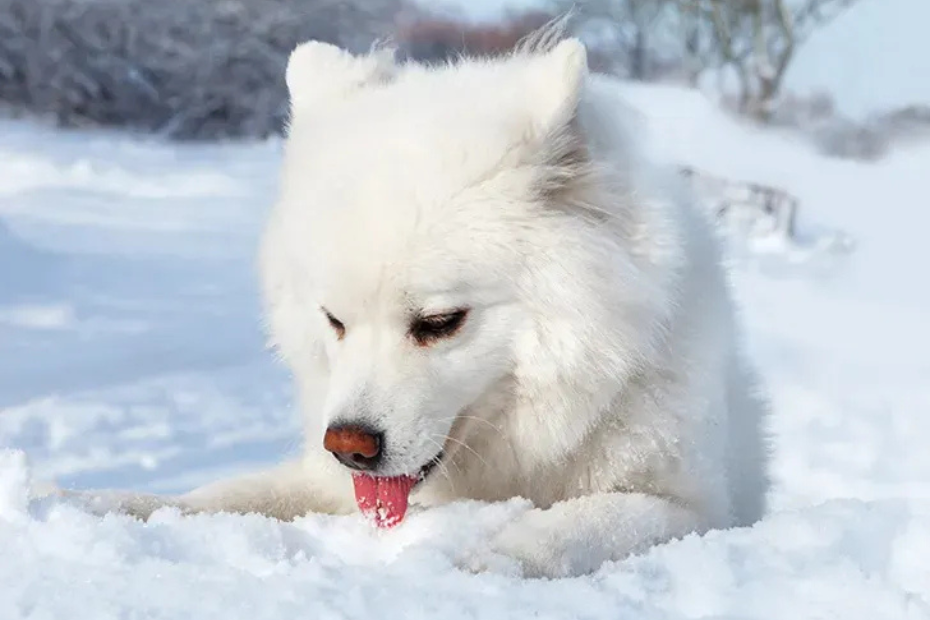Your dog appears to derive pleasure from rolling around and munching into snow drifts as you observe the distinctive pattern of each falling flake and the serene air that envelopes the world in a fresh white blanket. Therefore, what is the reason for your dog consuming snow? Additionally, is it considered to be typical?
Why Dogs Eat Snow
The same reasons humans open their mouths as snow descends from the sky or eat a handful off their mitten are likely the reason dogs enjoy eating snow. Snow is delectable. It is distinct from a variety of other edibles and beverages. It hydrates and melts in our mouths in a delightful manner.
Andy Rollo, DVM, a veterinarian and co-owner of Madison Veterinary Hospital and Walnut Lake Animal Hospital in the suburbs of Detroit, states, “I am uncertain as to whether dogs should consume snow, but a significant number of them do.” “I have a friend who does this, and I am under the impression that it is for his own amusement.” But my seven-year-old son also does, so that is not particularly significant.
There are a few other reasons why your dog could be eating snow, including:
Thirst: It is a prevalent misconception that canines are less susceptible to dehydration in the snow than they are in the heat. Your dog is experiencing some degree of dehydration when he is engaged in physical activity. Ensure that your dog receives an adequate amount of water throughout the day to maintain appropriate hydration.
Health condition: Dogs with health conditions such as diabetes, incontinence, vomiting, or kidney disease may also require an additional supply of water.
It is enjoyable!
Rollo’s primary concern regarding snow is the potential contents that may be concealed within it once it settles on the ground and mixes with the soil, grass, or pavement.
Is Eating Snow Bad for Dogs?
However, where has that snow been and what has it been intermingled with since it was dumped on the ground? There are a few primary potential hazards that should be observed.
Toxic Ice Melts
Accidental ingestion of small quantities of certain treatments designed to prevent water from freezing on driveways and roads is permissible. Schmid, however, contends that this is not the case for the majority of remedies implemented by municipalities and organizations. “This is especially a problem where an area has been shoveled or plowed, and then ice melt has been scattered there.”
Ice melts frequently contain ions, which can lead to hypernatremia (an excess of sodium in the bloodstream) and induce neurologic symptoms, such as seizures. Calcium, magnesium, and potassium are present in other ice melts at hazardous levels. The dog’s body may experience electrolyte abnormalities as a consequence of consuming an excessive amount.
Mushrooms, Compost, and Other Rotted Vegetation
Chemical ice melts are detrimental enough; however, canines may be exposed to toxic substances when they consume melted snow from the wet, wintry ground. “Rotted vegetation and compost can contain mycotoxins, which cause stomach upset and neurologic problems in dogs,” Schmid emphasizes. “Mushrooms may cause mild stomach upset, neurologic signs, or liver and kidney failure, depending on the mushroom type.”
Rat Poison
Many householders employ rodenticides to control the invasion of rats and mice from the outdoors during the winter. Schmid, on the other hand, asserts that these toxins may contaminate snow if they accumulate beneath or around the frozen water. Additionally, they are toxic to canines. “Rodenticides can cause bleeding disorders, neurologic signs, or kidney failure depending on the type,” Schmid asserts.
Miscellaneous Leftover Spills
According to Rollo, a dog’s eager, lapping tongue may also detect a spill of antifreeze (which can cause renal failure) or other chemicals in melting or contaminated snow. “Make sure there’s nothing leaking onto the snow that could be harmful to a dog,” the veterinarian suggests.
This should not cause you to be apprehensive about allowing your dog to play in the snow; rather, it necessitates that you be attentive to the location where your dog chooses to consume snow (and be cautious of the yellow variety).
Schmid asserts that canines are not affected by plain snow.
Rollo concurring: “If dogs want to lap up a fresh morning snowfall, let ’em do it.”

